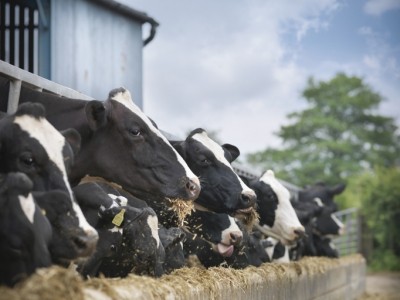More milk, less carbon: Fat supplement proves a high yielder in commercial dairy trials

Envirolac, a palm-free alternative to calcium soap developed by UFAC UK, had already been proven to increase dairy milk yields and quality while offering a lower carbon footprint when compared with palm-based fat alternatives.
Initial trials had shown that the feed additive had a third of the carbon footprint of the palm-based control supplement and reduced the feed carbon footprint per kilogram of milk by 11%. In addition, cows fed the palm-free calcium soap produced 0.6kg more milk and increased butterfat levels from 3.85% to 4.01%, with no impact on dry matter intake.
These results already suggested improved carbon emissions and feed conversion efficiency performance – but recently-completed trials at commercial farms in the UK have yielded even better results.
The trials took place at five Co-op Dairy Group farms in collaboration with Müller Milk & Ingredients and dairy sustainability consultancy Kite Consulting. The commercial research was carried out over a total of 436 animals, with an average of 73 animals across five herds, at between 7-100 days in milk.
During those trials, cows that were fed Envirolac recorded a total average milk yield increase of 0.8kg above the initial trial data, and an average increase of 1.4kg compared to the 0.6kg improvement over the palm-based calcium soap in the original trial. In addition, the farms’ feed carbon footprint was reduced by more than 10% on average, thanks to the supplement’s lower carbon footprint, equivalent to a third of that of palm-based fat supplements.
Milk solids were also raised, but more in line with the original results, at 0.10kg versus 0.13kg originally.
Nigel Bateson, UFAC UK special projects manager, told us that it’s relatively uncommon for a commercial pilot to produce better results than the original research. “Research trials are conducted under known, controlled conditions of environment, feed, management, animal age and spread and genetics,” he explained.
“When reproduced under commercial conditions, there is less control over some or all of these. Hence, for a commercial trial to achieve better results than the research trial is not the most common result and therefore represents a strong endorsement of the feed supplement’s integrity and value to the commercial farmer.”
Unlike traditional calcium soap which is produced from a single source of fat, e.g. palm oil or palm derivatives, Envirolac is a palm-free blend of vegetable and marine oils. Its carbon footprint is 64% lower than a comparable palm-based alternative, which in turn leads to reductions in the carbon footprint per kilogram of milk.
According to nutritionist Mike Chown, who oversaw the trials on behalf of UFAC-UK, the commercial trial results were nothing short of impressive. “We saw a higher yield response from the commercial studies than the university trial, with similar butterfat and protein improvements, and overall increased feed conversion efficiency,” he explained.
The improved milk production and feed conversion metrics suggest the palm-free product is also more nutritionally-dense, as Nigel Bateson confirmed: “Envirolac replaced calcium soap on a like-for-like weight basis with all other inputs remaining constant. By yielding more milk and milk constituents from the same quantity in the feed, it shows that the nutritional content of Envirolac is more available to the cow.”
He added that the oil blend that the feed additive is made of ‘provides a specific, unique, balanced profile of fatty acids in the feed’.
“This fatty acid profile has been developed to promote the response in milk yield and milk constituents. The inclusion of ingredients in the supplement to stimulate rumen buffering combined with its better palatability and digestibility results in improved feed conversion efficiency.”
Using the feed additive may also have positive implications for farmer income, as reducing feed costs and increasing milk yield and quality would theoretically improve farmer profitability. Bateson told us there were farm results representing a ROI of up to 25:1 during the commercial trials.
What are the environmental benefits of feed additives?
While global dairy consumption is tipped to improve only slightly - according to OECD-FAO, consumption of fresh dairy products will grow 1.0% per year until 2029 – producers are increasingly balancing profitability with efforts to improve their businesses’ climate performance, driven by demand from stakeholders and customers.
Meanwhile, a perfect storm of geopolitical tensions has put pressure on animal feed prices in recent years; leveraging solutions that improve feed efficiency can therefore contribute to reducing feed costs.
As for sustainability, dairy majors including Danone and Nestlé are turning to technical solutions including novel feed additives to reduce their climate impact from agriculture. While campaigners have argued that those solutions may only offer small improvements, companies continue to investigate the scope for moving the needle through improved feed management.














